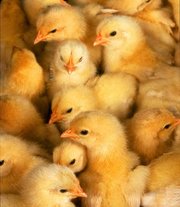Chicken sexer
|
|
A chicken sexer is a person who has been specially trained to determine the sex of chicken hatchlings.
| Contents |
Who wants to sex chickens?
Chicken sexing is practised mostly by large commercial hatcheries, who have two different feeding programmes, one for the females who are destined to lay eggs for commercial sale, and the others for the males, most of whom will be fattened up for sale as meat. The chicken sexer puts the chicken hatchlings on the appropriate track early, enabling those chickens to receive optimal nourishment for their likely commercial role from an early age. Different segments of the poultry industry sex chickens for various reasons. In the factory farm that produces eggs, males are unwanted; for meat production, separate male and female lines for breeding are maintained to produce the hybrid birds that are sold for the table, and chicks of the wrong sex in either line are unwanted. Early culling of chicks of the unwanted sexes reduces costs.
How to sex a chicken
There are two chief methods of sexing chicks: feather sexing and vent sexing.
Feather sexing
Feather sexing is easy, but it requires that the chickens be specially bred to manifest their sex in differences in the feathers as hatchlings. Male chickens in these breeds have longer wing pinfeathers than the females do, which makes them relatively easy to tell apart. Most chickens do not have these traits bred into them, and the hatchlings are identical to all but the skilled eye of the professional chicken sexer.
Vent sexing
Vent sexing is not easy. The sexual organs of birds are located within the body; the professional vent sexer has studied their external appearance, which can fall into as many as fifteen basic patterns, and learned to identify which ones are male and which female. Vent sexing is a difficult trade to master; many professional vent sexers are Japanese, where the art originated. The mystery of vent sexing was revealed to the Western world when a seminal paper was published in Japan in 1933 by Professors Masui and Hashimoto, which was soon translated into English under the title Sexing baby chicks. After Masui and Hashimoto's discovery, interested poultry breeders brought in people who had been trained by them to teach the art, or sent representatives to Japan to learn it. The skill is complex and has been likened to skill at playing chess and other crafts or games where pattern recognition is the key to success.
The chicken sexing machine
In the 1950s, several machines were invented that illuminated and magnified the cloacas of newborn chicks, and chicks could be sexed by inspecting them with this machine. This method is obsolete; only two manufacturers made the machines, and both have left the business.
As chickens grow up. . .
Small poultry farmers whose operations are not of sufficient size to warrant hiring a chicken sexer must wait until the hatchlings are four to six weeks old before learning the sexes of their chickens. At that time their secondary sex characteristics begin to appear, so anyone can sex a chicken.
External links
- Poultry: Sexing of day-old chicks (http://msucares.com/poultry/management/poultry_sexing.html)
- Japanese chicken sexing championship (http://www.financialexpress.com/fe/daily/20010212/fec12088.html)
- The art of chicken sexing (http://www.dpi.qld.gov.au/poultry/15032.html)
- Gender identification of chickens prior to hatch (http://www.wattnet.com/library/DownLoad/ed102sex.pdf) (PDF)
- Abstract: The art of chicken sexing (http://cogprints.ecs.soton.ac.uk/archive/00003255/) - a cognitive science discussion
- The art of chicken sexing (http://cogprints.ecs.soton.ac.uk/archive/00003255/01/chicken.pdf) - full article (PDF)

